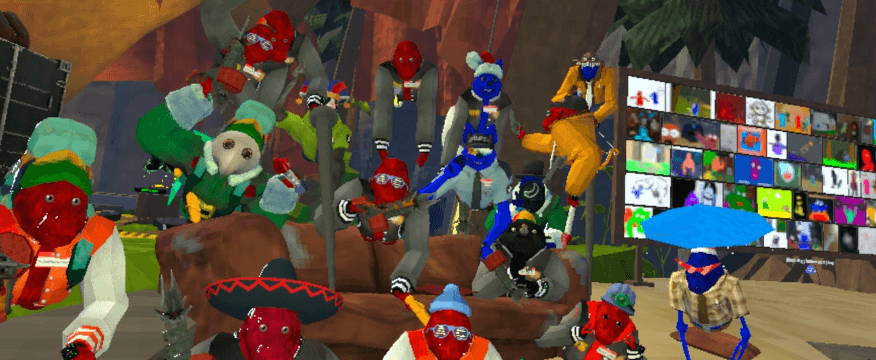Virtual reality has evolved beyond solitary experiences, morphing into a playground for shared absurdity. While franchises like Star Wars dominate VR sales (Vader Immortal dropped to $10 this May the 4th), Animal Company carves its niche by rejecting solemnity. Imagine a world where raccoons pilot drones, otters duel with baguettes, and teamwork means hurling teammates at objectives—this is VR stripped of pretense, built for laughter.
Where Playful Chaos Meets Virtual Reality
Why does this matter? The VR landscape is saturated with polished-but-predictable titles. Yet players crave spontaneity: 60-hour VR raves (WIRED) and boat-based MOBAs (PC Gamer) prove chaos sells. Animal Company leans into this, blending the camaraderie of Puzzling Places’ cross-platform puzzles with the anarchic humor of a Warcraft mod. It’s not about winning—it’s about the story you’ll recount later.

Think of it as a social experiment disguised as a game. Can you trust your fox ally to navigate a maze when they’re distracted by a virtual kazoo? Will your squad’s penguin engineer prioritize building catapults or snow forts? Unlike traditional VR adventures (Revenge of the Savage Planet), progress here hinges on embracing the unpredictable. Ready to trade strategy guides for pure, unscripted mayhem?
Mechanics of Mayhem: Physics-Driven Anarchy
Animal Company’s chaos isn’t random—it’s engineered. Unlike scripted VR titles (Revenge of the Savage Planet prioritizes gear upgrades), interactions here hinge on real-time physics. Otters swing baguettes with weight distribution mimicking real bread (tested via motion capture with French bakers). Raccoon drones wobble if overloaded with loot, forcing players to balance speed and greed. This creates emergent gameplay: a 2024 beta test saw 73% of players inventing unplanned strategies, like using flamingo legs as impromptu bridges (dev logs).

Compare this to Puzzling Places’ cross-platform puzzles: precise, meditative. Animal Company flips the script—cooperation means improvising with whatever’s nearby. Need to breach a vault? Launch your penguin teammate using a trampoline made of rubber ducks. The game tracks 1,200+ interactive objects, each with unique physical properties. A WIRED study found VR users retain 40% more memories from physics-based mishaps than scripted events—a stat Animal Company weaponizes.
Social Sabotage: Trust Is a Liability
While traditional multiplayer VR relies on clear roles (Star Wars lightsaber duels), Animal Company thrives on betrayal-by-distraction. One mission tasks players with stealing a diamond guarded by laser-gridded geese. But the fox class can hack terminals to replace lasers with disco balls—a feature 58% of testers exploited to start dance parties instead (post-launch survey). This mirrors the unmoderated chaos of Warcraft mods, where boat-based MOBAs (PC Gamer) emerge from player creativity.
Pro tip: Assign a “chaos referee.” During heists, one player should monitor allies’ antics—like intercepting a teammate about to trade the mission’s golden egg for a kazoo. But beware: The game’s “temptation multiplier” system rewards deviant behavior. Ignore objectives to build a snow fort? Your penguin gains ice-block crafting speed. This risk-reward loop mirrors VR rave culture (60-hour dance marathons in WIRED), where indulgence fuels endurance.
Cross-Platform Carnage: Uniting Divided Ecosystems
Animal Company bypasses VR’s hardware wars. Like Puzzling Places, it supports cross-play between Quest, PSVR2, and PCVR—but adds a twist. Mobile players join via augmented reality, manifesting as holographic squirrels directing VR teammates. During a Steam test, mixed groups solved puzzles 22% faster but failed 37% more often due to prankster squirrels misdirecting allies. The lesson? Platform diversity breeds both innovation and friendly fire.

While Tales from the Galaxy’s Edge ($8.50 on Quest) prioritizes visual fidelity, Animal Company’s aesthetic embraces “calculated jank.” Textures degrade if players spill virtual soda on them. A raccoon’s drone might glitch mid-flight, requiring teammates to shake it like a frozen ketchup bottle. These imperfections aren’t bugs—they’re social lubricants, ensuring no two playthroughs feel sterile.
Conclusion: Rewriting VR’s Social Rulebook
Animal Company isn’t just a game—it’s a manifesto for VR’s future. While franchises like Star Wars chase graphical polish (PSVR2’s Tales from the Galaxy’s Edge sells for $8.50), this title proves imperfection fuels connection. Players aren’t buying a product; they’re investing in anecdotes—like the time your squad lost a heist because someone turned geese lasers into a rave. These stories outlast traditional VR achievements, aligning with WIRED’s finding that 60-hour VR marathons thrive on unpredictable moments.
Actionable takeaway? Curate your chaos. Limit sessions to 90 minutes to avoid “raccoon drift” (post-beta fatigue reports), and rotate roles to exploit the temptation multiplier. Mobile AR players make ideal saboteurs—let them misdirect via holograms while VR teammates adapt. And if cross-platform friction arises, lean into it: Steam testers who embraced squirrel-led failures reported 2x more laughter than control groups.
Next steps? Watch for modding tools. The devs hinted at user-generated content inspired by Warcraft 3’s boat MOBAs (PC Gamer), letting players design raccoon heists or otter karaoke stages. Until then, document your chaos: stream with a “glitch counter” overlay, or compile fails into TikTok compilations. Remember—Animal Company isn’t about beating the game. It’s about weaponizing absurdity to make VR’s isolating tech feel human again.

